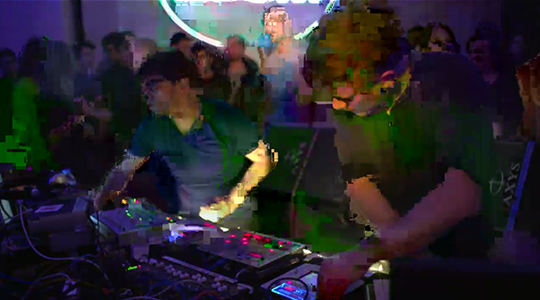Mouse On Mars
[DE]

Since emerging in the early 1990s, Mouse on Mars has been on a perpetual course of reinvention, indulging in complex, heavily hybridized forms that include everything from ambient, techno, and dub to rock, and post-rock. They’ve taken electronica to new levels with fragmented melodies and an aversion to what’s expected.
Over more than ten years and a dozen albums, Mouse on Mars have set about creating new musical languages, only to tear them down again with each new distortion, proving that since getting together in 1993, the duo Jan St. Werner, from Düsseldorf and Andi Toma, from Köln are one of the few electronic groups to stand the test of time. The pair began work in Werner's studio, sharing an enthusiasm for the early experiments of German electronics like Kraftwork, and Krautrock outfits like Can, Neu!, and Kluster, and incorporating the influences the burgeoning German techno and ambient scenes into offbeat demos. One demo found its way to London-based guitar/ambient group Seefeel, who passed it on to the offices of their label, Too Pure. The label was quick to release Mouse on Mars’ first single “Frosch”, and their debut album, Vulvaland (1994) soon after, which received immediate acclaim for its unusual sound and mood. The next album, Iaora Tahiti (1995), was more upbeat. Mouse on Mars were included on compilations, notably a pair of tribute albums: the 1995 Folds And Rhizomes for Gilles Deleuze Sub Rosa and Mille Plateaux’s In Memoriam Gilles Deleuze (1996) – dedicated to the French poststructuralist philosopher.
The next installments came in 1997 with three different releases – the EP Cache Coeur Naif, the long-player Autoditacker, and the initially vinyl-only Instrumentals on their own label Sonig. Idiology (2001) introduced a brace of live instrumentalists into the mix, including percussionist/collaborator Dodo Nkishi who was taken more permanently into the fold. In 2004, the duo celebrated a decade's worth of work with the release of Radical Connector and a global tour, captured by 2005's concert album Live04, apparently culled from over 600 hours of material. In late 2006, the polarizing Varcharz was released by Ipecac, the US label founded by Mike Paton.
Werner is also half of Microstoria with Markus Popp of Oval. In 2005, he also became the artistic director of the Amsterdam Institute for Electronic Music, STEIM.
Mouse on Mars has done a few collaborations. Early on, they were in a band/collective called Esognomig that included Ramon Bauer, Frank Dommert, Tina Frank and Florian Hecker; they released an eponymous long player on Sonig in 1999. MoM also worked with Mathew Herbert in the DJs Collapse project that resulted in the Jawfunk 12” in 2003. They also worked with Mark E. Smith of The Fall in a band called Von Südenfed.
In 2012, Mouse on Mars hit their tenth album with Parastrophics, released on Modeselektor’s Monkeytown label, and in 2013, the duo self-released two albums: Presents MOMCAST004 - Akustische Und Theoretische Grundbegriffe Part One and WretchDubbed.


